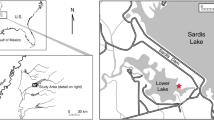Abstract
Resistivity of plastic litter to chemical weathering, mechanical erosion, and biological degradation poses a critical environmental threat. Plastic debris has increased in abundance over the past several decades along shorelines and at sea, where organisms mistake small particles including plastic pellets as a potential food supply. These pellets have been shown to adsorb persistent organic pollutants such as PCBs, which may endanger the organism and become ingested higher in the food chain. Although several studies have been conducted to determine the amount and effects of plastics pollution in marine environments, relatively little is known concerning fresh water plastics pollution. This study represents the first detailed examination of the distribution, types, and physical and chemical degradation processes of plastic particles in a fresh water setting. In conducting field surveys along the shoreline of Lake Huron, Canada, we were able to ascertain that the total number of pellets over multiple sampling localities comprise 94% of plastic debris. The majority of the pellets were found proximal to an industrial sector along the southeastern margin of the lake and their abundance steadily decreased northward, following the dominant lake current patterns. Laboratory analyses using Fourier transform infrared spectroscopy (FTIR) and scanning electron microscopy indicate predominant mechanical abrasion textures, including grooves, gauges, pits, and flakes, and less common chemical weathering features such as linear and crescentic fractures that developed from shrinkage during subaerial exposure. The predominant type of plastic, polyethylene, appears to be much more resistant to chemical weathering than polypropylene, as indicated by oxidation peaks on FTIR spectra suggesting that polypropylene degrades more readily under natural conditions on freshwater beaches.



Similar content being viewed by others
References
Arutchelvi, J., Sudhakar, M., Arkatkar, A., Doble, M., Bhaduri, S., & Uppare, P. V. (2008). Biodegradation of polyethylene and polypropylene. Indian Journal of Biotechnology, 7, 9–22.
Barnes, D. K. A., Galgani, F., Thompson, R. C., & Barlaz, M. (2009). Accumulation and fragmentation of plastic debris in global environments. Philosophical Transactions of the Royal Society, 364, 1985–1998.
Biesinger, M. C., Corcoran, P. L., & Walzak, M. J. (2010). The degradation of plastic on marine and lacustrine beaches. Surface and Interface Analysis. doi:10.1002/sia.3397.
Blight, L. K., & Burger, A. E. (1997). Occurrence of plastic particles in seabirds from the eastern North Pacific. Marine Pollution Bulletin, 35, 323–325.
Cooper, D., & Corcoran, P. L. (2010). Effects of mechanical and chemical processes on the degradation of plastic beach debris on the island of Kauai, Hawaii. Marine Pollution Bulletin, 60, 650–654.
Corcoran, P. L., Biesinger, M. C., & Grifi, M. (2009). Plastics and beaches: A degrading relationship. Marine Pollution Bulletin, 58, 80–84.
Derraik, J. G. B. (2002). The pollution of the marine environment by plastic debris: A review. Marine Pollution Bulletin, 44, 842–852.
Endo, S., Takizawa, R., Okuda, K., Takada, H., Chiba, K., Kanehiro, H., et al. (2005). Concentration of polychlorinated biphenyls (PCBs) in beached resin pellets: Variability among individual particles and regional differences. Marine Pollution Bulletin, 50, 1103–1114.
Environment Canada (2008). National Pollutant Release Inventory Database. (http://www.ec.gc.ca/inrp-npri/default.asp?lang=En&n=B85A1846-1, accessed Dec 6th, 2009).
Eyles, N. (2002). Ontario rocks (p. 339). Ontario: Fitzhenry and Whiteside.
Gregory, M. R. (1977). Plastic pellets on New Zealand beaches. Marine Pollution Bulletin, 8, 82–84.
Gregory, M. R., & Andrady, A. L. (2003). Plastics in the marine environment. In A. L. Andrady (Ed.), Plastics and the environment (pp. 379–401). New Jersey: John Wiley & Sons Inc.
Laist, D. W. (1987). Overview of the biological effects of lost and discarded plastic debris in the marine environment. Marine Pollution Bulletin, 18, 319–326.
Mallory, M. L., Robertson, G. J., & Moenting, A. (2006). Marine plastic debris in northern fulmars from Davis Strait, Nunavut, Canada. Marine Pollution Bulletin, 52, 813–815.
Mato, Y., Isobe, T., Takada, H., Kanehiro, H., Ohtake, C., & Kaminuma, T. (2001). Plastic resin pellets as a transport medium for toxic chemicals in the marine environment. Environmental Science & Technology, 35, 318–324.
Moore, C. J. (2008). Synthetic polymers in the marine environment: A rapidly increasing, long-term threat. Environmental Research, 108, 131–139.
Powers, M. C. (1953). A new roundness scale for sedimentary particles. Journal of Sedimentary Petrology, 23, 117–119.
Reddy, M. M., Gupta, R., Gupta, R. K., Bhattacharya, S. N., & Parthasarathy, R. (2008). Abiotic oxidation studies of oxo-biodegradable polyethylene. Journal of Polymers and the Environment, 16, 27–34.
Rios, L. M., Moore, C., & Jones, P. (2007). Persistent organic pollutants carried by synthetic polymers in the ocean environment. Marine Pollution Bulletin, 54, 1230–1237.
Ryan, P. G., & Moloney, C. L. (1993). Marine litter keeps increasing. Nature, 361, 23.
Saylor, J. H., & Miller, G. S. (1979). Lake Huron winter circulation. Journal of Geophysical Research, 84, 3237–3252.
Sheng, J., & Rao, Y. R. (2006). Circulation and thermal structure in Lake Huron and Georgian Bay: Application of a nested-grid hydrodynamic model. Continental Shelf Research, 26, 1496–1518.
Wang, W., Wang, Q., & Dang, W. (2009). Polyethylene composite property change after exposed to UV weathering. Journal of Reinforced Plastics and Composites, 28, 1813–1822.
Acknowledgments
We would like to thank Rebecca Jacklin and Heather Bloomfield for their help with the analyses and David Cooper for the assistance in the field. Thanks go out to Editor in Chief J.T. Trevors and an anonymous reviewer for improving the manuscript. This study was supported by the second author’s NSERC Discovery Grant.
Author information
Authors and Affiliations
Corresponding author
Rights and permissions
About this article
Cite this article
Zbyszewski, M., Corcoran, P.L. Distribution and Degradation of Fresh Water Plastic Particles Along the Beaches of Lake Huron, Canada. Water Air Soil Pollut 220, 365–372 (2011). https://doi.org/10.1007/s11270-011-0760-6
Received:
Accepted:
Published:
Issue Date:
DOI: https://doi.org/10.1007/s11270-011-0760-6




